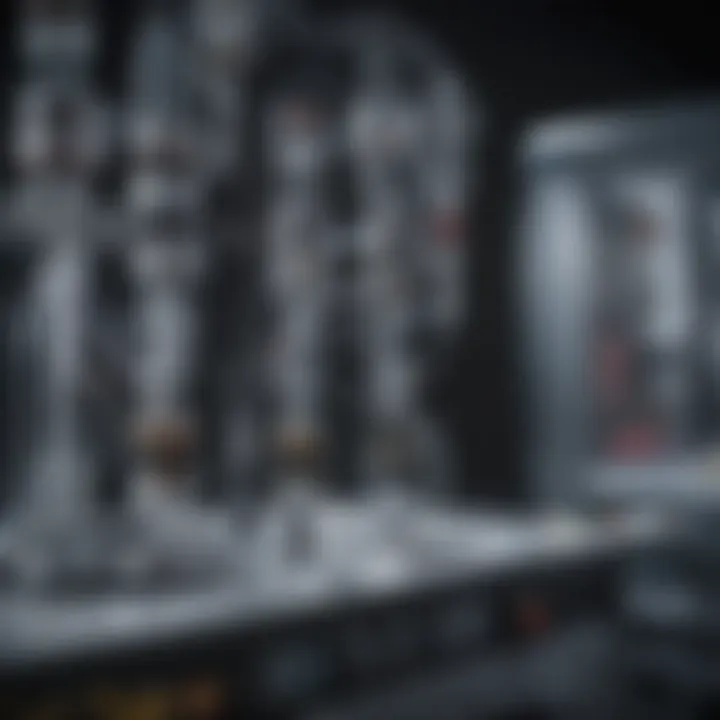Automated Anesthesia: Innovations and Implications


Intro
The evolution of anesthesia practice has been marked by significant advancements, particularly in the realm of automated systems. As technology progresses, the integration of automation in anesthesia aims to enhance operational efficiency and improve patient safety. This article delves into the innovations surrounding automated anesthesia, examining both the potential benefits and challenges that arise from its use in clinical settings.
Automated anesthesia systems represent a paradigm shift in how anesthetic agents are administered during surgical procedures. These systems leverage sophisticated algorithms and real-time data to optimize drug delivery, thus minimizing human error and improving patient outcomes. The increasing complexity of surgeries demands precision, and automated systems are designed to meet this need. Beyond efficiency, these innovations also prompt critical discussions regarding their impact on the practice of anesthesiology and the ethical implications of introducing artificial intelligence into patient care.
As we explore the detailed facets of this topic, it becomes essential to consider the tools and methodologies that underpin the development of automated anesthesia. A comprehensive understanding of the technology and its application will facilitate informed discourse surrounding its role in future medical practices.
Prolusion to Automated Anesthesia
Automated anesthesia represents a significant transformative force in modern medical practice. As surgical procedures have become more complex and patient populations more diverse, the demand for anesthesia solutions that enhance precision and consistency continues to grow. This section delves into the significance of automated anesthesia, examining its historical backdrop and the scope of its applications within the medical field.
Historical Context
The evolution of anesthesia can be traced back to the mid-19th century, coinciding with the advent of surgical procedures that required profound levels of pain control. The introduction of ether by Crawford Long and nitrous oxide by Horace Wells marked the beginning of modern anesthesia. Over the decades, anesthesiology has dramatically transformed, introducing various techniques and agents. Automated anesthesia began to emerge in the latter part of the 20th century, driven by advancements in technology. Initial systems relied on rudimentary mechanisms for gas administration. However, as computers and electronics advanced, so did the systems, evolving into the sophisticated automated platforms used today that integrate real-time monitoring and delivery of anesthetic agents.
Definition and Scope
Automated anesthesia refers to the use of technology to assist in the delivery and management of anesthetic agents during a medical procedure. This encompasses an array of systems that automate the administration of anesthetics, monitor vital signs, and adjust dosages based on feedback from various sensors.
The scope of automated anesthesia extends beyond the operating room. These systems have applications in diverse fields like obstetric care and pain management. The integration of artificial intelligence within these systems enhances predictive analytics, allowing for more personalized anesthesia management tailored to individual patient needs. The continued advancements in automated systems are not only improving patient safety and outcomes but also raising important considerations regarding ethics and regulatory frameworks. This complex landscape necessitates a thorough understanding of both the benefits and potential limitations associated with automated anesthesia.
Technological Foundations
The technological foundations of automated anesthesia are critical to understanding how these systems enhance modern medical practices. As the field evolves, the integration of advanced technologies plays a significant role in improving the delivery of anesthesia, ensuring patient safety, and optimizing clinician workflow. The automated systems rely heavily on electronic and software components, which allow for precise control and monitoring of anesthetic agents. This section will examine the core components of these systems and the vital role played by sensors and monitoring devices.
Components of Automated Anesthesia Systems
Automated anesthesia systems are composed of various integral parts that work together to facilitate effective anesthesia management. Key components include:
- Delivery Mechanisms: Automated systems utilize electronic pumps to administer anesthetic agents. These pumps can deliver precise dosages based on real-time patient data, significantly reducing the likelihood of human error.
- Drug Reservoirs: They come equipped with reservoirs for both volatile and intravenous anesthetics. The differing properties of these drugs are considered carefully during system design to allow for efficient delivery.
- Control Software: This software ensures that the delivery mechanisms operate correctly. It allows healthcare providers to set specific parameters for drug delivery based on the patient's needs.
- User Interface: A user-friendly interface is critical. This feature allows practitioners to control the system easily, access patient data, and monitor conditions without hassle.
By integrating these components, automated anesthesia systems offer not only efficiency but also enhanced safety. Such systems provide a streamlined approach to managing anesthesia during various medical procedures.
Role of Sensors and Monitoring Devices
The incorporation of sensors and monitoring devices is crucial in automated anesthesia systems. These technologies provide real-time feedback on several vital patient parameters, which influence anesthesia management. Some essential roles include:
- Vital Sign Monitoring: Continuous monitoring of heart rate, blood pressure, and oxygen saturation is vital. Sensors ensure that any changes in a patient’s condition are immediately detected, allowing for timely adjustments to anesthesia delivery.
- Depth of Anesthesia Monitoring: Specialized sensors can assess the depth of anesthesia. This data helps clinicians determine whether a patient is adequately anesthetized, reducing the risk of complications during surgery.
- Respiratory Monitoring: Monitoring devices assess respiratory patterns, helping to ensure that ventilation support is adequate. This is especially important in surgeries where general anesthesia is utilized.
The integration of these sensors enhances not only patient safety but also improves overall outcomes by providing real-time data to the clinical team.
The effectiveness of automated anesthesia systems lies in the seamless interaction of all their components, supported by advanced sensor technology. By prioritizing these technological foundations, modern anesthesia practice continues to evolve, promoting better health outcomes for patients.
Artificial Intelligence in Anesthesia


The integration of artificial intelligence (AI) in anesthesia practice embodies a significant advancement within the medical field. As technology evolves rapidly, the role of AI in facilitating automated anesthesia systems is increasingly critical. AI enables the development of algorithms that analyze real-time data, providing accurate information that can aid in decision-making during anesthetic management. This section seeks to explore the components that make AI vital in modern anesthesia, outlining its benefits and considerations.
Machine Learning Mechanisms
Machine learning (ML) is a subset of AI that empowers systems to learn and improve from experience. In anesthesia, ML mechanisms are instrumental in synthesizing extensive datasets from patient histories, anesthesia protocols, and outcomes. This process informs the recommendations made to anesthesiologists.
For instance, by analyzing data on various patient demographics and medical conditions, ML models can predict responses to anesthetic agents. This prediction capability promotes personalized anesthesia, minimizing risks and optimizing dosages. The use of ML also enhances predictive maintenance of anesthesia equipment, identifying potential failures before they occur. The resulting efficiency contributes to better-managed anesthesia processes, as practitioners can focus more on patient care rather than equipment reliability.
Predictive Analytics in Patient Care
Predictive analytics plays a crucial role in contemporary patient care within the realm of anesthesia. By employing algorithms that utilize patient data, predictive analytics can forecast potential complications during surgical procedures. These analytics assess multiple factors such as vital signs, medical history, and specific patient characteristics, allowing for proactive interventions.
For example, AI-driven predictive models can indicate the likelihood of postoperative nausea and vomiting (PONV) based on individual risk profiles. This information allows anesthesiologists to tailor preoperative management strategies effectively. Such tools not only provide insights into patient safety but also enhance overall surgical outcomes. The results are tangible benefits for patients, reducing recovery times and associated complications.
The implementation of predictive analytics in anesthesia represents a paradigm shift, emphasizing the necessity of data-driven decisions for improved patient outcomes.
Clinical Applications
Automated anesthesia systems represent a significant shift in the practice of anesthesia, offering enhancements in efficiency and accuracy. Understanding the clinical applications of these systems allows for an appreciation of their transformative impact on surgical procedures, patient care, and overall healthcare outcomes. Each specific medical context benefits from automation in distinct ways, with implications for patient safety, resource allocation, and procedural efficiencies.
Surgical Settings
In surgical settings, automated anesthesia technologies help to streamline perioperative processes. These systems can modulate the delivery of anesthetic agents precisely according to the patient's physiological responses. This precision reduces the risk of human error, especially under high-pressure situations where quick decision making is critical. The active monitoring of vital signs and responses allows for on-the-fly adjustments, ensuring optimal dosage delivery tailored for each patient’s unique needs.
Furthermore, automated systems can enhance communication among surgical teams through integrated data-sharing capabilities. Surgeons and anesthesiologists can access real-time data analytics, which informs decision-making during procedures. This integration not only fosters collaboration but also contributes to improved outcomes for patients undergoing various surgical interventions.
Obstetric Care
In obstetric care, the application of automated anesthesia is particularly meaningful. Expectant mothers often present unique challenges, where traditional techniques may pose risks to both mother and child. Automated systems can offer enhanced control over anesthetic delivery during labor practices, such as epidurals. By relying on automated systems, anesthesiologists can ensure more consistent pain management with minimal drug-related side effects, leading to a better overall experience for the patient.
Moreover, the automation reduces the workload on healthcare providers, allowing them more time to focus on patient interaction and monitoring. In obstetric settings, where emotional and physical support is crucial, this shift can improve care quality significantly.
Pediatric Anesthesia
Pediatric anesthesia presents a complicated landscape where tailored approaches are essential. Automated systems can play a crucial role here as well. Children metabolize drugs differently than adults, complicating dosage calculations and management. Automated anesthesia tools can facilitate weight-based dosing adjustments, thereby increasing safety and efficacy in this sensitive demographic.
In addition, automated systems incorporate real-time monitoring and adjustments. Anesthesiologists can track various parameters such as heart rate or respiratory effort closely. This capability is particularly important in pediatric care, where early detection of any abnormalities can lead to quick interventions that may save lives. Engagement with automated systems in this context represents a commitment to providing the highest standard of care to vulnerable populations.
Important Note: The integration of automated anesthesia in clinical applications marks a pivotal enhancement in anesthesiology, indicating a shift towards data-driven, patient-centered care, while maintaining critical oversight by trained professionals.
Patient Safety and Efficacy
Automated anesthesia systems bring forth critical advancements in patient safety and overall efficacy during medical procedures. By integrating sophisticated technologies and artificial intelligence, these systems enhance the precision of anesthetic delivery, thus minimizing risks associated with human error. It is imperative to consider how these innovations not only streamline the anesthetic process but also ensure patient well-being throughout surgical procedures.
Impact on Patient Outcomes


The introduction of automated anesthesia has notably improved patient outcomes. Studies indicate that the use of these systems correlates with a reduction in adverse events during surgeries. The mechanisms by which patient outcomes improve can be attributed to various factors:
- Accurate Dosing: Automated systems rely on real-time data to adjust dosages of anesthetic agents, reducing the chances of overdose or under-dose. This real-time monitoring addresses the unique needs of each patient effectively.
- Consistent Monitoring: Continuous surveillance of vital signs helps in promptly identifying any anomalies. When a patient’s parameters deviate from the norm, automated systems can alert physicians, allowing for immediate intervention.
- Reduced Recovery Times: Patients often experience shorter recovery periods post-surgery due to minimal fluctuations in vital signs throughout the procedure. This efficiency is beneficial not only for patient health but also for overall hospital throughput.
"The adoption of automated systems has changed how we approach anesthesia, setting new standards for safety and effectiveness" - Anesthesia Specialist.
Error Reduction Mechanisms
One of the most compelling arguments in favor of automated anesthesia is its role in reducing human errors, which have long been a significant concern in the medical field. These error reduction mechanisms include:
- Standardized Protocols: Automated systems operate within defined protocols, minimizing variability in practice. This consistency ensures that every patient receives the same high standard of care.
- Data-driven Decisions: The use of machine learning algorithms allows these systems to learn from vast amounts of data. They continually improve their decision-making capabilities, thus anticipating potential complications before they arise.
- Alert Systems: Alerts generated by the system when deviations from standard parameters occur create a safety net. Anesthetists can focus more on patient interaction and less on monitoring equipment, thereby enhancing both safety and care quality.
In summary, the integration of automated anesthesia systems is reshaping patient safety paradigms and outcomes in surgical practices. By emphasizing precision, real-time monitoring, and error reduction, these innovations are fundamentally augmenting the efficacy of anesthesia management.
Ethical and Regulatory Considerations
The integration of automated anesthesia into modern practice raises numerous ethical and regulatory considerations that demand careful examination. As automation in healthcare grows, practitioners must navigate the complex interplay between efficiency and ethical patient care. This section aims to clarify vital elements surrounding informed consent and the need for standardization of clinical protocols. Understanding these factors is essential for ensuring patient trust and maintaining high standards of care in surgical environments.
Informed Consent Practices
Informed consent is a cornerstone of ethical medical practice. With automated anesthesia systems, the dynamics of obtaining consent can become more intricate. Health care providers must clearly communicate how automated systems function, including their benefits and risks. Patients often have questions regarding the role of artificial intelligence in managing their anesthesia and the effectiveness compared to traditional methods.
It is crucial that practitioners provide thorough explanations, ensuring patients understand:
- The mechanisms of automated anesthesia systems.
- The expected advantages, such as precision dosing and real-time monitoring.
- Potential risks, which may include system malfunctions or reliance on technology.
Moreover, consent must remain an ongoing dialogue. As technologies advance and new features are introduced, revisiting consent becomes important. Continuous education for patients helps maximize their understanding and comfort level with automated methods.
"Informed consent is more than just a signature. It's about ensuring patients are truly aware of what they are agreeing to."
Standardization in Clinical Protocols
Standardization in clinical protocols is essential for the safe deployment of automated anesthesia systems. With varying levels of sophistication in these technologies, healthcare professionals need a consistent framework to guide their use. This ensures that all practitioners follow best practices, which in turn enhances patient safety.
Developing comprehensive standards can support:
- Uniform Training: Clinicians must have access to standardized training programs about the specific automated anesthesia technology they use. This reduces variability in skill among practitioners.
- Quality Control: Regular audits can ensure that automated systems operate within the established protocols and adhere to safety guidelines.
- Compliance: Regulatory bodies may create frameworks that outline minimum standards, ensuring that automated anesthesia systems are implemented effectively and ethically.
Establishing clear protocols may ease concerns related to autonomy in anesthetic management. A balance must be struck between automation and the necessary human oversight to safeguard patient welfare.
Limitations of Automated Anesthesia
Automated anesthesia systems bring forth many advancements. However, it is critical to address their limitations. Understanding these constraints illuminates the balance between innovative technology and the essential human element in anesthesiology. This section will focus on two main areas: technological constraints and the necessity of human oversight.
Technological Constraints


Even with numerous advancements, automated anesthesia systems are not without flaws. One significant limitation is the reliability of the technology. Sensors and algorithms can experience malfunctions or inaccuracies. This can lead to inappropriate dosing of anesthetic agents, harming patient safety.
Additionally, many systems lack the flexibility required to adapt to individual patient needs. Each patient presents unique physiological responses and comorbidities. Automated systems based on standardized protocols may not account for these variations. As a result, automated anesthesia can sometimes lead to less personalized care.
"The effectiveness of automated anesthesia depends not only on the technology itself, but also on how well it integrates into the specific clinical environment."
Moreover, the data produced by automated systems needs constant analysis. The complexity of these data means that misinterpretation is possible, leading to errors in patient management. Errors could arise from system design or user input. Consequently, thorough training is pivotal for clinical staff using these systems.
Human Oversight in Practice
While automation offers many benefits, it cannot fully replace human judgment. Automated systems require skilled anesthetists for oversight. Their experience and intuition are irreplaceable. For instance, in unexpected situations, human professionals must make swift decisions that machines cannot.
Furthermore, the presence of human oversight enhances patient trust. Patients often feel more secure knowing that a skilled anesthesiologist is monitoring their care. The human connection cannot be replicated by machines. Therefore, this element remains vital, even as automated systems become more prevalent.
Anesthesiologists must be involved in the decision-making process about the use of automation in practice. Their insights help bridge the gap between technology and effective patient care.
Future Directions in Anesthesia Automation
The exploration of future directions in anesthesia automation is essential for both medical innovation and patient care. As we continue to witness rapid advancements in technology, the field of anesthesia stands to benefit significantly from automated systems. These innovations promise enhancements in accuracy, efficiency, and patient safety. Additionally, shifts in healthcare dynamics and the rising demand for minimally invasive procedures necessitate that automated systems evolve. Hence, exploring the future of anesthesia automation is vital in ensuring that the practice adapts to our evolving medical landscape.
Innovative Research Areas
Research in anesthesia automation covers various intriguing domains. Here are some innovative areas currently being explored:
- Adaptive Anesthesia Algorithms: One area of focus is the development of algorithms that can adapt in real-time to patient responses. This includes technology that assesses physiological signals to modify anesthetic delivery.
- Integration of Biomarkers: Another frontier is the use of biomarkers, which can offer insights on patient condition. By integrating this data, automated systems can provide more personalized anesthesia.
- Enhanced Monitoring Techniques: Innovations in non-invasive monitoring are also crucial. This can lead to better tracking of vital signs, thereby enhancing safety during anesthesia.
- Tele-Anesthesia Applications: The growth of telemedicine has prompted research into remote anesthesia management models. This can allow for better resource allocation and potentially expand access to surgical care in under-served regions.
Focusing on these areas of research will likely yield systems that not only improve efficacy but also ensure enhanced outcomes for patients undergoing surgical procedures.
Potential for Integration with Other Technologies
The integration of anesthesia automation with other medical technologies showcases a promising avenue for the future. Here are critical points to consider:
- Artificial Intelligence and Machine Learning: Utilizing AI can improve decision-making processes within automated systems. Machine learning models can analyze vast amounts of data to predict complications, thereby allowing for preemptive measures.
- Robotics in Surgical Environments: Anesthesia systems are beginning to interface with robotic surgical systems. This integration can optimize the timing and delivery of anesthetics, depending on the surgery type and patient specifics.
- Interconnectivity with Electronic Health Records (EHR): Future automated anesthesia systems will likely need seamless connectivity with EHRs. Such systems can ensure that clinicians have access to comprehensive patient data, leading to informed and timely decisions.
- Smart Wearable Devices: The rise of wearables offers opportunities for continuous monitoring. These devices can track patient vitals pre- and post-operation and feed information into anesthesia systems for real-time adjustments.
Combining these technologies holds the potential for groundbreaking improvements in the field of anesthesia, enhancing both patient safety and clinical efficiency.
Continued investment in research and development in anesthesia automation will redefine how anesthesia is administered, bringing forth unparalleled advancements in the field.
The End
The conclusion of this article serves as a vital summation of previously discussed topics, particularly regarding automated anesthesia systems. This area of medical practice has evolved significantly, reflecting advancements in technology and a greater focus on patient safety and efficacy. The integration of automated systems promises not only to enhance the quality of anesthetic delivery but also to reshape traditional practices in anesthesiology.
One of the major elements emphasized is the role of artificial intelligence in predictive analytics, which can lead to more tailored anesthetic interventions for patients. Moreover, the potential for error reduction through automated systems can enhance overall surgical outcomes, aligning with broader healthcare goals for safety and quality. Ultimately, understanding these conclusions allows medical professionals and researchers to appreciate the significance of automation in this context.
Summary of Key Points
- Technological Innovations: The article discusses the technological advancements that have paved the way for automated anesthesia systems. This includes components such as sensors and monitoring devices, which play a crucial role in enhancing patient safety.
- Clinical Applications: These systems have shown efficacy in various clinical settings including surgeries, obstetrics, and pediatrics, allowing for precise anesthesia management tailored to patient needs.
- Patient Safety: A focus on error reduction and the impact of these systems on patient outcomes indicates a promising trend towards improved safety and reduced incidence of adverse events.
- Ethical Considerations: Regulatory challenges and ethical issues around informed consent are crucial, ensuring that patients are adequately informed about these advanced practices.
- Future Directions: The article also touches on potential areas for future research and the integration of other technologies, hinting at a continuous evolution in anesthesia practices.
Closing Thoughts on Automated Anesthesia
As we move forward, it is essential to examine the lasting implications of automated anesthesia. The pursuit of improved patient outcomes must remain a priority as we embrace these innovative technologies. There is also a need for ongoing education and training for professionals in the field to ensure they are equipped to handle these advancements effectively.
Ultimately, automated anesthesia systems represent a transformative approach in modern medicine. They hold potential not just for elevating standards of care but also for redefining the landscape of anesthesiology itself. Being mindful of both the capabilities and limitations of these systems will be crucial as we continue to explore their utility in clinical practice.







